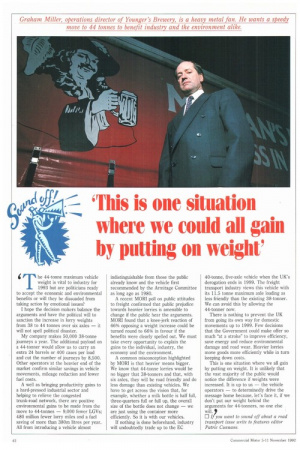(14 4 .if f 'This is one situation
Page 44

If you've noticed an error in this article please click here to report it so we can fix it.
where we could all gain by putting on weight'
4 T he 44-tonne maximum vehicle weight is vital to industry for
1993 but are politicians ready to accept the economic and environmental benefits or will they be dissuaded from taking action by emotional issues?
I hope the decision makers balance the arguments and have the political will to sanction the increase in lorry weights from 38 to 44 tonnes over six axles — it will not spell political disaster.
My company makes 50,000 38-tonne journeys a year. The additional payload on a 44-tonner would allow us to carry an extra 24 barrels or 400 cases per load and cut the number of journeys by 8,500. Other operators at the heavier end of the market confirm similar savings in vehicle movements, mileage reduction and lower fuel costs.
A well as bringing productivity gains to a hard-pressed industrial sector and helping to relieve the congested trunk-road network, there are positive environmental gains to be made from the move to 44-tonnes — 9,000 fewer LGVs; 480 million fewer lorry miles and a fuel saving of more than 380m litres per year. All from introducing a vehicle almost indistinguishable from those the public already know and the vehicle first recommended by the Armitage Committee as long ago as 1980.
A recent MORI poll on public attitudes to freight confirmed that public prejudice towards heavier lorries is amenable to change if the public hear the arguments. MORI found that a knee-jerk reaction of 66% opposing a weight increase could be turned round to 66% in favour if the benefits were clearly spelled out. We must take every opportunity to explain the gains to the individual, industry, the economy and the environment.
A common misconception highlighted by MORE is that heavier means bigger. We know that 44-tonne lorries would be no bigger that 38-tonners and that, with six axles, they will be road friendly and do less damage than existing vehicles. We have to get across the vision that, for example, whether a milk bottle is half full, three-quarters full or full up, the overall size of the bottle does not change — we are just using the container more efficiently. So it is with our vehicles.
If nothing is done beforehand, industry will undoubtedly trade up to the EC 40-tonne, five-axle vehicle when the UK's derogation ends in 1999. The freight transport industry views this vehicle with its 11.5 tonne maximum axle loading as less friendly than the existing 38-tonner. We can avoid this by allowing the 44-tonner now.
There is nothing to prevent the UK from going its own way for domestic movements up to 1999. Few decisions that the Government could make offer so much at a stroke" to improve efficiency, save energy and reduce environmental damage and road wear. Heavier lorries move goods more efficiently while in turn keeping down costs.
This is one situation where we all gain by putting on weight. It is unlikely that the vast majority of the public would notice the difference if weights were increased. It is up to us — the vehicle operators — to determinedly drive the message home because, let's face it, if we don't put our weight behind the arguments for 44-tonners, no one else will. 9 D Ifyou want to sound off about a road transport issue write to features editor Patric Cunnane












































































